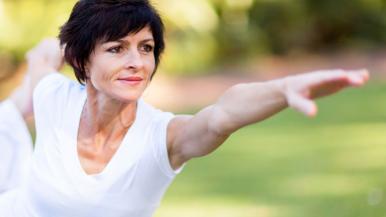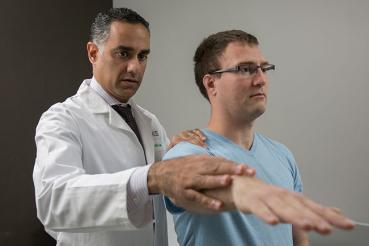It's important to make sure you're on track for good health if you're a woman in midlife. In fact, hitting the track could be just the thing to do.
According to Kathy Weber, MD, MS, a sports medicine specialist at Rush, the midlife years — 40s, 50s and 60s — are an important time for women to stay active and eat right for the long-term health of their bones and joints.
Women experience more bone loss with aging
The years can bring bone and joint problems for everyone. Simple wear and tear can lead to osteoarthritis, and the weight gain that often comes with age puts even more stress on joints.
For women, though, the story is more complicated. To begin with, a woman's bone mass is generally lower than a man's. And the decrease in estrogen that comes with menopause brings a higher risk for weak bones from osteoporosis.
Additionally, mechanical differences in the way women's thigh, hip and butt muscles are engaged — in combination with the angle between the hip and knee — puts them at a higher risk for injuries than men, especially injuries to the knee cap and anterior cruciate ligament, or ACL. In midlife, women are also at higher risk than men for overuse injuries, such as stress fractures and tendonitis.
Walk it off
With the extra risks women face, exercise might seem like a dangerous step. But the fact is, being fit is a good defense.
"If you don't exercise already, start now," Weber says. "Even 10 minutes a day is a good beginning."
A well-designed exercise program including aerobic exercise, stretching and lifting weights can help you avoid injuries. Weight-bearing activities, such as walking, jogging and dancing, can help keep bones healthy.
The secret is to begin slowly with an easy activity, such as walking, and build up to more strenuous exercise. Aim for at least 30 minutes of moderate-intensity physical activity — either all at once or 10 minutes at a time — on most days of the week.
But if it's been a while since you’ve been active, Weber advises talking to your doctor before you begin any exercise program to ensure you don't have any health problems that might make exercising risky.
Eating away at risk
In addition to regular moderate-intensity physical activity, a bone-healthy diet is essential.
"After about age 25, a woman's bone mass starts depleting instead of building, and menopause increases this loss," Weber says.
Calcium is the most important nutrient for bones, and vitamin D helps the body absorb it. In addition to finding both in dairy products and fish, some foods and beverages, such as orange juice, are fortified with calcium, and it’s in some green vegetables.
The amount of calcium and vitamin D you need varies with age, so make sure you’re getting enough — but not too much — at each stage of your life.
With the extra risks women face, exercise might seem like a dangerous step. But the fact is, being fit is a good defense.
Toast to your bone health
A study of women in their 50s and 60s, published in the journal Menopause, suggests that moderate alcohol consumption — one drink per day — may also help to prevent bone loss in older women.
The study revealed that moderate amounts of alcohol seem to slow down the bone turnover rate (the biological process by which bits of bone are dissolved, or reabsorbed, and new bone is formed). This slowdown may help protect women against fractures over time.
While further research is needed, these findings seem to fit with a prior discovery that people who are moderate drinkers have higher bone mineral density than heavy drinkers and those who don’t imbibe at all.
However, both the study authors and Weber caution that these potential bone-protective benefits don’t apply to men, or to girls and women in their teens and early 20s who are still building bone mass.
"If you're under the age of 25, you should focus on physical activity, eating right and getting enough calcium and vitamin D to ensure that your bones are healthy and strong," Weber says.
Taking a proactive approach to prevention
Weber advises having a baseline bone density test, or DEXA scan, for all women at age 65, or earlier if you are at high risk for developing osteoporosis. This allows you to start treatment as soon as necessary.
These things can put a woman in the high risk group:
- Being postmenopausal
- Being sedentary (not being physically active)
- Having a family history of osteoporosis
- Drinking large amounts of alcohol (more than one drink daily)
- Having a low body weight due to an eating disorder
- Not having menstruated for a long period of time
- Being a smoker
Comprehensive care for damaged joints
To help women of all ages with joint problems, Rush offers both traditional and advanced care, including the following:
- Joint replacement. Experts at Rush were instrumental in developing the first artificial knee designed specifically for women. It fits the narrower shape of women’s knees and accommodates the different angle at which a woman's knee moves over the end of the femur. Rush also offers highly specialized joint replacement procedures for the wrist and shoulder.
- Joint resurfacing. This alternative to joint replacement preserves bone, meaning full joint replacement can be done later if necessary.
- Therapies for osteoporosis. These include the latest medications and personalized diet and exercise counseling, such as can be found at the Rush Osteoporosis Clinic.
- Smoking cessation programs. Nicotine and other chemicals in cigarette smoke can be toxic to bones.
- Weight management programs. Being overweight puts extra stress on your joints.
More women than ever are healthy, active and strong at midlife and beyond, notes Weber. It's not too late to be one of them.




